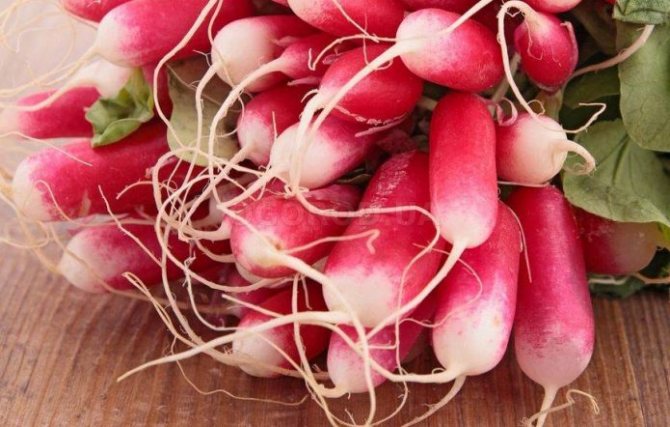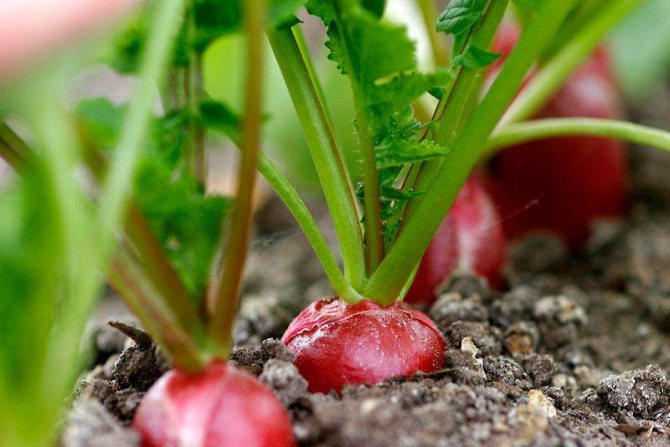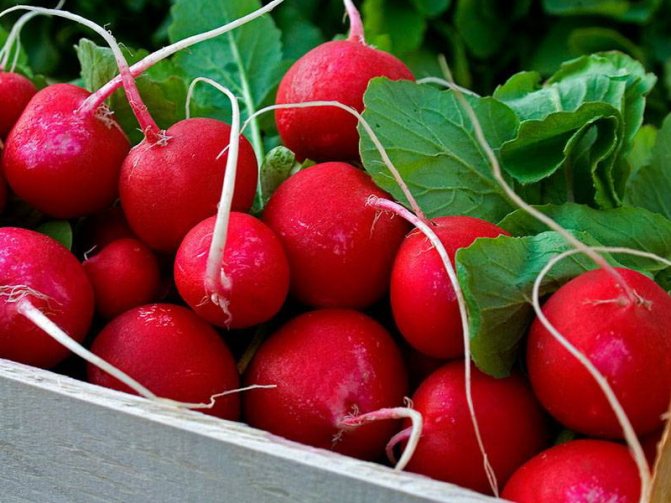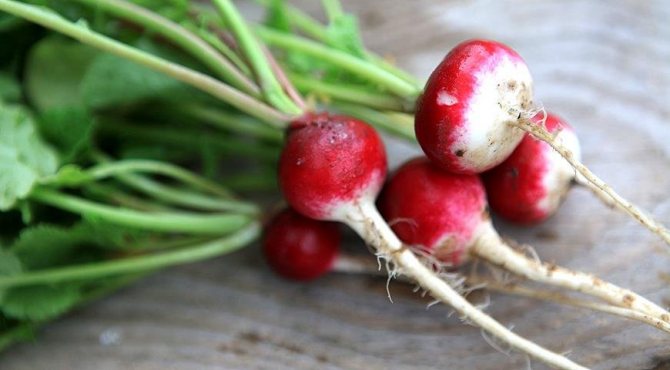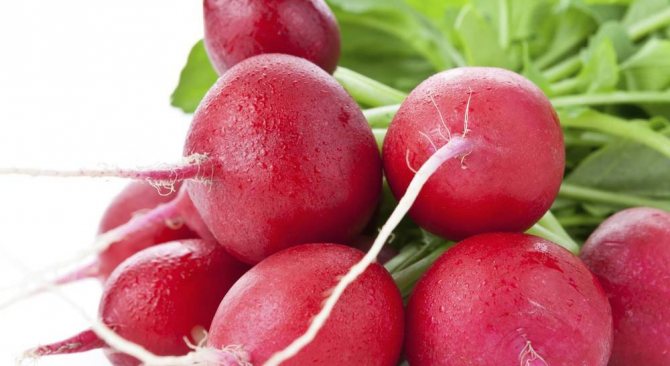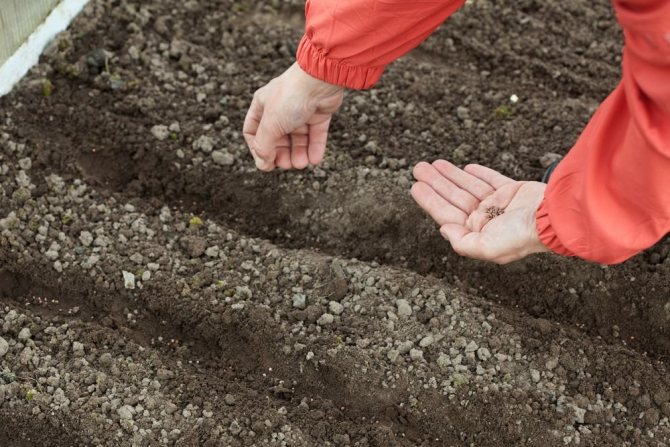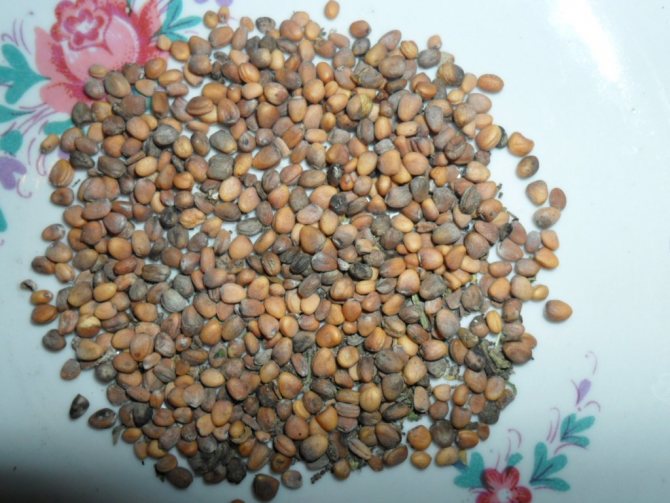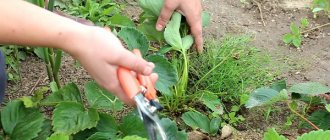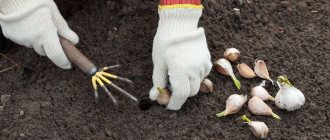Category: Advice for gardeners
Of the root crops grown in the garden and summer cottages of Russians, radish is the first to ripen. But not all experienced gardeners know: a pleasant event, when a salad or okroshka with a vegetable grown with his own hand appears on the table, can come as much as three weeks earlier. This chance is given by planting radishes in the open ground before winter.
- What varieties of radishes to choose
- Landing dates in autumn
- Step-by-step instructions for outdoor planting
Advantages and disadvantages of winter crops
Having planted radishes in autumn, you can count on a healthy, high-quality and early harvest, and all thanks to natural selection. The seeds will have to endure frosts in the ground, and only the strongest and strongest will rise in the spring. As a result, the quality of the crop rises sharply. It will even turn out to save a little time and effort on weeding. And you can collect the first root crops a few weeks earlier than with spring planting. If you are not too lazy and insulate the garden, you will be able to speed up this process for another week.

Quality early harvest of radish
Also, thanks to the melting of the snow cover, the radish will receive a sufficient amount of moisture and it does not need to be watered, the soil is moistened naturally. In addition, the seeds that have passed natural selection are hardened in winter, and young shoots are not afraid of small frosts, they are resistant to various diseases and insects. And, of course, do not forget about saving spring time.
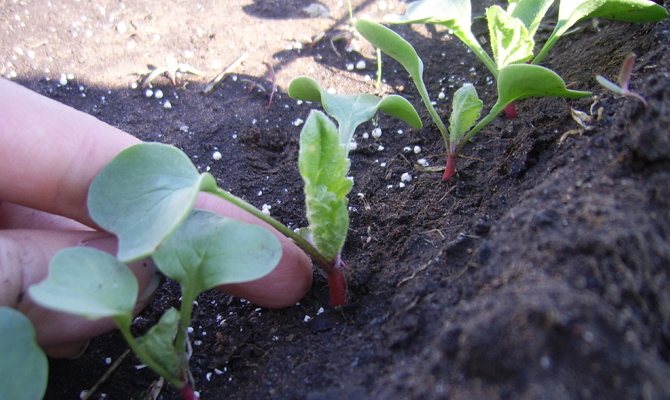

Frost-resistant young sprouts
Are there any disadvantages of planting radishes before winter? If it is wrong to withstand the technology, then there is a great risk that all your efforts will be in vain. Even a slight warming is dangerous, which can provoke the growth of seedlings, and subsequent frosts will simply kill them.
Which variety to plant before winter?
This planting has its own characteristics, so you cannot take the first seeds that come across. In order for the work to give good results, it is necessary to choose the right variety for sowing. Frost resistance is considered its main criterion. Also, the plant will lack sunlight. It is also important that the selected species does not shoot, since many, after a long stay in frozen ground, and then a sharp thaw, go to flowering shoots. At the same time, you will not be able to enjoy the fruits.
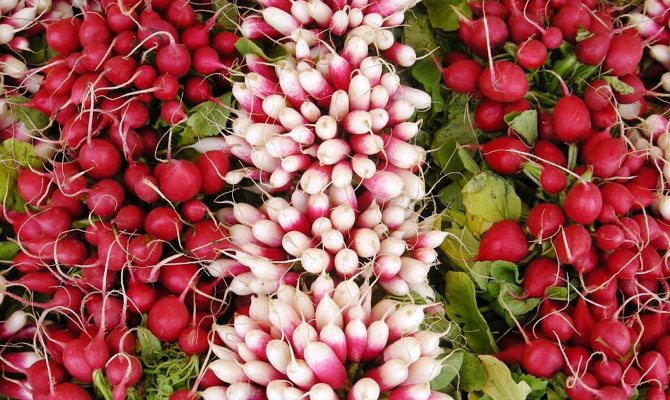

Frost-resistant radish varieties
Such varieties as "Zorya" and "Heat" are perfect for winter planting. They meet all the requirements, and the harvest pleases with its taste and quality. The ripening period of the first type falls on the 18-25th day after germination, and the second one a few days earlier. You can also plant a medium early pink-red variety. He will delight you with an excellent harvest in 3-4 weeks after germination. The main advantage of the latter is considered to be a mild and very pleasant taste.
Radish in winter. Growing radishes at home on a windowsill in winter
Growing radishes on your own at home is the easiest and fastest way to replenish your vitamin deficiency in the winter. The advantages of growing this particular vegetable in winter are early maturity, minimal care, simplicity of agricultural technology.There are radish varieties that only need two and a half weeks from planting to full maturity. By planting a vegetable in stages, you can provide yourself with fresh vitamins throughout the winter.
It must be said that not every type of radish is suitable for growing at home on a windowsill. You need to choose hybrids that have an ultra-early ripening period or early ripening varieties. Also, it should be shade-tolerant, drought-resistant, since in winter in city apartments, heating devices dry out the air too much. Insufficient moisture can provoke the blooming of the plant.
The most suitable varieties of radish for the windowsill:
- 1 "18 days" - as the name implies, the root crop ripens in eighteen days and it really is. Maximum three weeks - can be served at the table. A plant with excellent immunity, the color is bright red, the root crop is cylindrical, elongated, very juicy, not bitter.
- 2 "Duro" - fruits are spherical, large (about 40 grams), pale pink flesh. The early ripening variety "Duro" ripens in twenty-five (or so) days. Does not crack, resistant to stemming.
- 3 "Heat" - a round root vegetable with a dark red color. Ripens in about 27 days. Not a pungent taste, the flesh is tender, pink.
- 4 Ilka is another ultra-early variety. The ripening period is twenty days. The root crop is medium-sized, on average eighteen grams. Differs in a long shelf life. Very pungent taste.
- 5 "Camelot" is an early maturing hybrid. It has a round, slightly flattened shape. From planting the seed to the full ripening of the vegetable, it takes about twenty-five days. The variety is shade-tolerant. "Camelot" is unpretentious in care.
- 6 "Firstborn" - hybrid, ultra-early, ripens in just seventeen days! Round fruits weighing thirty-five (or so) grams. No arrows, dark red color.
- 7 "French Breakfast" is the most suitable variety (according to most experienced growers) for growing at home. “French breakfast” is the best choice for a beginner lover of home vegetable growing. The variety is unpretentious in care, does not go away, which is called a "tune". The seed ripens from germination in 20-23 days. Sharp taste, rich aroma. Fruit weight - up to forty-five grams.
- 8 "Helro" - Dutch hybrid does not need intense lighting. It perfectly tolerates insufficient humidity. An early ripe variety is ready for serving twenty days after germination.
What are we going to plant radishes in?
It is very important to choose the right landing time, and you should be guided mostly by weather conditions, and not by the date on the calendar. It is necessary that small frosts have settled outside the window, and if an increase in temperature is possible, then the thermometer readings should not jump over about. Having decided in time, the question arises, how to prepare a garden for sowing radishes before winter? Indeed, at sub-zero temperatures, the earth is difficult to cultivate, and this will significantly complicate the process. Therefore, you should worry about it while it is warm enough outside.
It is very important to choose the right place. Of course, radish is a moisture-loving plant, but if the winter turns out to be snowy, then there is a great risk that the seeds will simply be flooded with an excessive amount of melted snow. If they survive, then the excess fluid will still not be beneficial. Therefore, they plant radishes in a garden bed on a hill. Also, don't forget about this root vegetable's love for sunlight, so try to avoid shaded areas. Do not plant this plant even before winter in areas where radish, cabbage, horseradish, turnip and watercress grew. Tomatoes, beans, cucumbers, and potatoes, on the other hand, are good precursors.
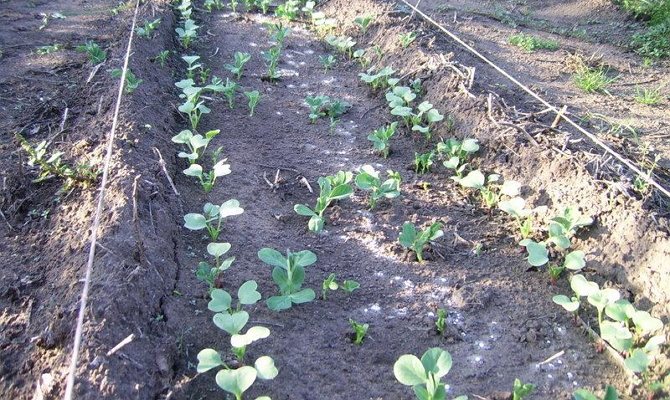

Planting a moisture-loving plant in the garden
The earth must be well dug up so that it is finely lumpy and loose, then it will properly envelop every grain, the presence of air gaps and voids is unacceptable.It is better, in general, to take the prepared soil and store it in a room where the temperature is above zero. If you forgot to prepare the soil with which you will sprinkle the seeds, then you can always buy it in specialized stores. Moreover, this soil is usually sold fertilized and has an excellent loose structure. Avoid heavy soil, as it becomes too compacted during the winter and it is difficult for sprouts to hatch out.
Be sure to apply phosphorus-potassium fertilizers. You can also add compost or humus at the rate of 2 kg per m2. Fresh manure cannot be used, otherwise the fruits will not be suitable for consumption. It is important that the acidity of the soil is weak, if this is not the case, then take all the necessary measures. Liming will help reduce acidity. Doses of materials are calculated depending on the severity of the problem. For example, it is possible to neutralize the strong acidity of the medium with slaked lime at the rate of 50–75 kg per hundred square meters; for medium acid soil, this dose is reduced to 45 kg.
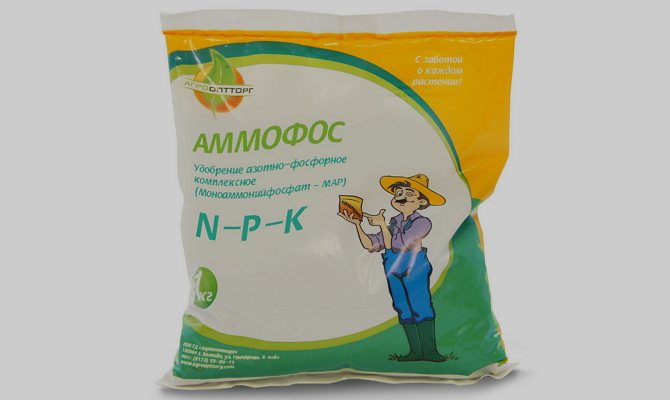

Phosphate-potassium fertilizers
You can also regulate the condition of the soil with the help of dolomite flour, it is an environmentally friendly product. Its dosage ranges from 600 to 450 g per square, depending on the acidity. Furnace ash, which is famous for its high content of calcium, phosphorus, potassium and other microelements, also helps very well in this matter. Its maximum rate is 7 kg per 10 squares. If you use ash as fertilizer, then 1 kg per square is enough.
Having prepared the soil, you should also worry about the garden beds, in winter, as already mentioned, the earth freezes, so we form them in the middle of autumn and cover them with a film so that the rains do not damage them and the wind does not bring in weed seeds. We make grooves no more than 5 cm deep at a distance of at least 10 cm from each other.
Landing dates in autumn
Determining the timing of sowing seeds is the most crucial moment. The main thing for a gardener when planting radishes in open ground before winter is not to miss the time when the air temperature will be 0 ° C, soil - from +2 to +4 ° C. For different climatic zones of Russia, this can be the end of October or November.
Here are the terms you can focus on:
- the second decade of October - in the central regions of Russia;
- early October - in the northern regions;
- late October or early November - in the south of the country.
If meteorologists promise warming, it is better to postpone planting. Otherwise, the radish seeds will begin to germinate, and the frosts that have replaced the warmth will destroy them. Experienced gardeners recommend sowing radishes when the topsoil freezes by about 3 cm.
What care does the garden need?
Calibrate the seeds just before sowing. To do this, put them in small portions in a weak solution of sodium chloride. It is prepared from the ratio of 2 tablespoons of salt to 1 liter of purified water. We keep them in liquid for a short time, and do not forget to stir. Good live seeds will sink to the bottom of the container, while empty ones float to the surface. After selecting suitable specimens, etch them with formalin solution. Seed consumption during winter sowing increases by at least 50%, since most of it will not sprout due to freezing or can be eaten by rodents. It is important that they are dry. You can not plant already germinated specimens, they have no chance of survival. Sow the prepared grooves with radishes.
You can pre-stick the seed on a paper tape. To do this, cut off a strip of toilet paper about 4 cm wide and using homemade glue made from potato starch or wheat flour, fix the seeds on it in 2 cm increments.
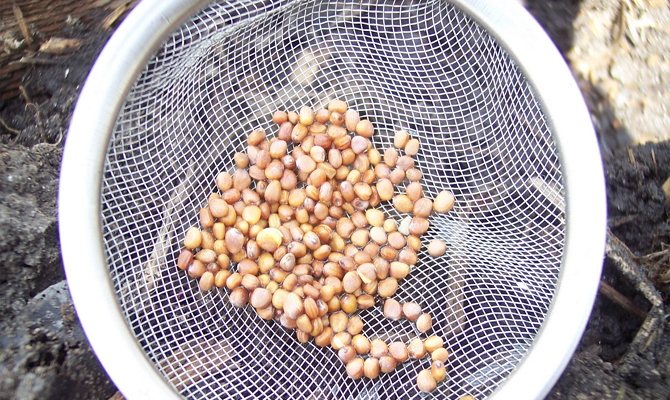

Seed preparation
During sowing, the soil does not need to be watered, since it is already sufficiently moist at this time of the year. Plus, additional irrigation can provoke the development of the plant, but it is useless.We fill the beds with good soil (no more than 2 cm), which we kept at home or purchased in the store. Next comes a three-centimeter layer of mulch. She is the best way to protect crops from destructive temperature changes. And also will not allow a crust to form on the soil with the arrival of spring.
Having considered how to plant radishes before winter, you should familiarize yourself with the technology of insulation. It is the same for most vegetables. Cover the beds with spruce branches; you can also use special synthetic materials. But foliage and straw will not be the best insulation for radish crops. The first accumulates moisture and can rot, and in the second, rodents often hide, which are not averse to feasting on seeds in difficult times. The shelter must be at least 15 cm high.
What steps to take in the spring?
With sowing measures, everything is clear, but how should you behave with the appearance of the first shoots? Indeed, for all its unpretentiousness, it is not uncommon for a radish to spend all its energy on the growth of tops, and the root crop practically does not develop. This is facilitated by an incorrectly chosen place, thickening and an excess of moisture. Therefore, in order to reap a good harvest, you should take care of the plant. With the appearance of the first shoots, monitor their density. If the plants are planted too close to each other, remove the weakest specimens without any regret. The optimal distance is considered to be at which the roots are not closer than 5 cm from each other.
It doesn't matter if the radishes were planted before winter, early spring or summer, but great attention should be paid to timely and moderate watering. With a lack of moisture, the fruit will be bitter, tough. In excess, tasteless and have a watery structure. You also need to moisturize evenly, otherwise the radish will begin to crack. Therefore, we focus on the weather and, if necessary, water the soil in small portions. Loosen the soil after each irrigation to avoid crusting. You can add a little nitrogen fertilizer in the spring, but do not overdo it, otherwise all the growth will go to the tops, and not the root crop.


Moderate watering of vegetable beds
Even warming radishes sown before winter can be attacked by small pests. The danger is represented by cruciferous fleas, you can fight them with folk remedies. We need ash and lime, taken in 1: 1 proportions. The last component can be replaced with tobacco dust. Pollination should start from the moment of emergence. It is enough to carry out 3 procedures with an interval of 4 days. A decoction of onion peels and feeding with a mullein will also help get rid of these pests.
There is one more pest that will have to be dealt with - the white beetle. For prevention, treat the plant with a solution prepared from mustard, salt, taken in 2 tbsp. l., and 1 tbsp. l. red pepper, diluted in 10 liters of water. But Bordeaux liquid and milk of lime (lime and water, taken in a ratio of 1:20) will help to overcome such sores as bacteriosis and keela. Also, the danger is a disease called "black leg". If she hit the plant, then it should be treated with a special solution. It is prepared from laundry soap (50 g) and copper sulfate (1 tbsp. L.), Diluted in 10 liters of water.
How to care for a root vegetable
The main rules of care are watering, feeding, treatment from diseases and pests. Autumn planting rules are somewhat different from spring ones. By itself, radish is such a garden crop, which is very fond of high humidity.
In order for the development to occur correctly, the humidity must be at least 80%, therefore the main recommendations for care are frequent systematic watering. It should be done daily to avoid the bitterness in the radishes.
If watering is insufficient, the root crop will develop poorly, with too much moisture, the plant becomes swampy, the root crop will crack. Autumn care rules are different from spring ones. After planting seeds at the end of autumn, the soil is mulched with dry material, watering is not carried out (when planting in a greenhouse, care is carried out differently).
When the soil is poor, the radish is fertilized twice during the entire growing season. When the radish grows on saturated soil, one top dressing will be enough for the entire growing season. In the greenhouse, feeding is carried out in a different way, since the substrate is different in its qualities.
It is not necessary to apply a large amount of nitrogenous fertilizers, since the crop will be poor and the tops will develop well. In order to subsequently form juicy and healthy roots, it is recommended to introduce into the soil:
- compost;
- humus;
- superphosphate;
- potash fertilizers;
- saltpeter;
- wood ash.
If the soil is fertile and saturated with many useful microelements, mineral fertilization will be sufficient before sowing planting material. When root crops grow in a greenhouse, care and feeding is carried out in a different way. For growing in a greenhouse, a fertile substrate is prepared in advance.
How long can the crop be stored?
We figured out the features of early varieties of radish, how to plant and care for them before winter, now we should learn a little about collection and storage. To prevent the fruits from cracking, you need to reduce watering before weeding. It is quite easy to pull the radish out of the soil; you just need to grab the tops with both hands and pull. Then we form small beams and cut off the green part with scissors or a sharp knife.


A small bunch of winter radishes
We wash the root crop under running water, dry it thoroughly and put the fruits in the refrigerator. They can be stored in it without compromising quality for about a month. If you need to keep the radish for a longer period, you can pack it in airtight bags and place it in the freezer. You can not remove the side roots, they contribute to a longer storage of the product.

